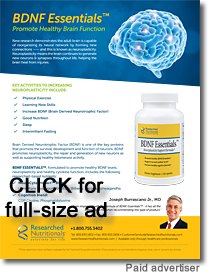Page 1, 2
Prostate Cancer
A number of factors play a role in the development of prostate cancer (CAP) such as age, race, environmental exposures to toxins, diet and nutrition, endocrine system dysregulation, and genetics. The risk of prostate cancer increases steadily after age 40 until a peak incidence is reached about age 80. Pre-malignant changes seen in younger men often do not become apparent until much later in life, thus contributing to the increasing incidence seen with aging. As there are a number of factors involved with the development of CAP, aging alone does not necessarily mean that one will develop the disease.
Most prostate cancers arise in the peripheral zone away from the urethra and therefore symptoms of urinary obstruction develop later on. If the symptoms of obstruction are due to cancer of the prostate, it generally means that there is a significant amount present.
Approximately 20% of all prostate enlargements are the result of cancer. About 80% of these cancers are of the slow growing variety, do not metastasize readily and often cause little if any problem. A smaller percentage of these cancers may spread quickly depending upon the type and location of the lesion.
Populations with diets high in animal fats and refined sugar and lower in fiber and vegetable intake have much higher incidences of cancer of the prostate. High animal fat intakes, as well as the development of obesity, has been shown to have one of the strongest associations with prostate cancer. Men from cultures traditionally with low incidences of CAP, who migrate to the United States, develop the cancer at rates comparable to those of their American counterparts. If however, they retain their native diets, the incidence does not increase as much. As a number of studies have shown, with all other contributing factors being equal, diets high in fiber, fruits and vegetables result in a lower incidence of prostate as well as other cancers.
Environmental factors play a variety of roles in the development of CAP. Often there are several factors which contribute over a period of time, but some seem to play a greater role than others. It has been noted that there are higher rates of prostatic cancer in males who are exposed to chemical toxins. Occupations in industries such as petrochemical, rubber and textile are among the highest in number of CAP cases. Urban, as opposed to rural areas, have higher incidences of CAP, which is felt to be due to air and other pollutants.
Cadmium has also been implicated in cancer of the prostate as a much higher incidence is found in men who work with batteries. Zinc is normally found in high concentrations in the prostate gland and will be displaced by cadmium.
Allergies
Allergies of the genital urinary tract (GU) are an often unrecognized and under-diagnosed condition that can be the cause of considerable discomfort. More often than not symptoms are associated with an infection for which antibiotics are prescribed that ultimately have no effect. There are generally three areas of allergic reactions associated with the GU tract: Contact dermatitis involving the penis and scrotum in men and labia, vagina and perineum in women; the lower urinary tract, involving the urethra and bladder in women, and urethra, bladder and prostate in men; and the kidneys and ureters.
Signs and symptoms include edema, swelling, inflammation, and itching during an acute episode, often with no fever present. Swelling can be severe. There is often frequency, urgency, dysuria, nocturia, and a dull, suprapubic ache that accompany lower urinary tract allergic reactions. Often there is no fever or pyuria present; but flank pain, gross hematuria, and occasional urinary retention may be present.
Frequent urination at night or bedwetting is one of the most commonly encountered conditions associated with food allergy. Patients with asthma, hay fever, migraine, and urticaria are also frequently found to have urinary symptoms related to allergies as well.16-18
Proctalgia Fugax
Proctalgia fugax is a functional anorectal disorder that occurs due to muscle spasm and cramping of the rectal musculature. The patient experiences a severe and often debilitating pain for which a triggering event or agent may or may not be identified. A comparable condition due to spasm of the levator ani also produces similar symptomology. Often this occurs at night when the person is recumbent and more relaxed and is generally intermittent in nature.
I mention these conditions because often men believe that they have chronic prostatitis because some of the symptoms such as difficulty with urination, burning of the perineum, and pain with urination occur. Other contributing conditions such as anal fissure, hemorrhoids, or injury to the coccyx need to be considered.
Prevention the Best Cure
A reasonable approach to treating male genital urinary tract disease is preventing them before they even start. While this seems to be a reasonable approach, men's illnesses in American culture are often viewed as a weakness, and therefore symptoms are frequently ignored or dismissed. Men more often than not are seen when their diseases are in advanced stages making it more difficult to treat. Conventional medical treatments as mentioned previously, are designed to suppress symptoms so that the patient can quickly get back to work or their careers, which ultimately leads to chronicity of the disease.
 Some things to consider when developing preventive treatment plans are educating men about diet and nutrition, supplementation, herbal medicines for urinary tract health and lifestyle changes. Developing strategies for prevention of any disease should also provide for screening exams and lab studies so that they can be recognized early on. These can include periodic urinalysis, PSA, fasting chemistry screen and lipid panels, and inflammatory markers such as CCRP, and ferritin. Some things to consider when developing preventive treatment plans are educating men about diet and nutrition, supplementation, herbal medicines for urinary tract health and lifestyle changes. Developing strategies for prevention of any disease should also provide for screening exams and lab studies so that they can be recognized early on. These can include periodic urinalysis, PSA, fasting chemistry screen and lipid panels, and inflammatory markers such as CCRP, and ferritin.
Diet and Nutrition.
As mentioned previously, populations with diets high in animal fats and refined sugar and lower in fiber and vegetable intake have much higher incidences of cancer of the prostate while those that are higher in fruits and vegetables generally do not.19-21
Overall, I recommend a balanced diet that is high in protein and vegetables, lower in carbohydrates and very low in fat. I also utilize diets based upon the patient's blood type in order to decrease the effects of dietary lectins in the development of disease and in particular, allergic reactions.22
I also counsel men about their drinking habits, especially beer. Most men do not realize that in order to lower the calories in light beers so they supposedly will not put on weight, the hops content is increased to add flavor. Hops are highly estrogenic which will affect estrogen receptors in the prostate as well as around our midsections. No wonder some men have trouble urinating and can no longer see their shoes!
Antioxidants such as vitamin C, E, resveratrol, and green tea are helpful in eliminating free radical formation while enhancing cellular oxidation. These support the inflammatory process as well, allowing it to complete its work in a timely manner to restore normal homeostasis. Other supplementation with zinc, magnesium and B complex, especially B6, also provides benefit; and these are often part of prostate health formulas.23
Identifying Potential Toxic Exposures.
Environmental factors also play a variety of roles in the development of prostate disease but especially CAP. Often it is several factors which contribute over a period of time, but some seem to play a greater role than others. It has been noted that there are higher rates of prostatic cancer in males who are exposed to chemical toxins. Occupations in industries such as petrochemical, rubber and textile are among the highest in number of CAP cases. Urban, as opposed to rural areas, have higher incidences of CAP which is felt to be due to greater exposure to industrial pollutants. Higher rates of CAP are seen in smokers as well as exposure to arsenic.24 As previously mentioned, cadmium which displaces zinc, has also been implicated in cancer of the prostate as a much higher incidence is found in men who work with batteries.
Most of the adverse effects of heavy metals and persistent organic pollutants such as PCBs, phthalates, pesticides, polychlorinated biphenyls (PCB), chlorinated compounds and heavy metals are found to affect fertility by lowering sperm counts while fostering the production of abnormal sperm. Erectile dysfunction due to lower testosterone levels is also found. In particular, phthalates, PCBs, perfluorocarbons and bisphenol A contribute to lower testosterone levels and hypogonadism.24
Assessing Genetic Risk Factors
A family history of prostate cancer increases the likelihood of developing CAP. Men, who have a past history of frequent or chronic prostatitis, also are at somewhat of an increased risk for CAP. Genetic factors seem to play a role, as there are higher incidences of CAP in some families than others, especially if there is a father or brother with the disease. An early onset of the disease, in males less than 55 years old, suggests a familial predisposition. Black American males show a 50% higher incidence than whites.
Certain blood types such as Type A and AB show higher incidences of CAP than their O and B counterparts. Non-secretors also appear to be at higher risk. Urinary tract infections, including cystitis, are found to be higher in blood group B and AB types with O and A types having lower rates.25 These are because proteins on certain bacteria and cancer cells are similar to those of the host, and as such are not as easily identified by the immune system.26
More recently genetic testing has become better able to predict the possibility of developing certain diseases and can be used to help develop individualized prevention strategies.
Lifestyle Modifications
There are many over-the-counter prostate supplements that are used by men for BPH, prostatitis, CAP and to promote prostate health. While these do provide some benefit when treating various male GU diseases, their real value is in their use as a preventive as they provide what is needed to keep the prostate healthy. I begin to talk with men in their late 30s about using prostate formulas as a preventive against the effects of aging.
Some other things to consider are to keep the interstitial fluid environment pH from becoming acidic by encouraging men to eat the requisite amounts of fresh fruits and vegetables. And yes, they can drink alkaline water to do this, but fresh fruits and vegetables contain far more nutrients and minerals that are needed to decrease inflammation. Keeping systemic inflammatory processes low for any condition is important not only for prostate health but for health in general. Use of anti-inflammatories to accomplish this is somewhat counterproductive, and identification and removal of the cause is preferable.
Promoting pelvic blood and lymph flow through the use of hydrotherapy and exercise is beneficial to maintain health of the male genital-urinary tract. This can be accomplished with a variety of natural therapies and exercise programs. Urinating following intercourse and ejaculation cuts down on the potential for exposure to microorganisms from the vaginal tract.
Reducing chronic stress27,28 and finding one's spiritual center are important to help balance our bodies, minds, and spirits as well as pursuing those things we love to do to make our lives fulfilling and rewarding. Talking to our male patients early on about recognition and prevention of disease in general but prostate disease in particular will help decrease the incidence of male genital urinary morbidities.
Page 1, 2
References .pdf
 Thomas A. Kruzel, ND, received a BA in biology from the California State University at Northridge, and his Doctorate of Naturopathic Medicine from the National College of Naturopathic Medicine. He is the author of the Homeopathic Emergency Guide – A Quick Reference Handbook to Effective Homeopathic Care, published by North Atlantic Books and Haug Publishers Germany, and Natural Medicine Pediatric Home Health Advisor. He has also published numerous articles in The Journal of Naturopathic Medicine as well as other publications, been a member of the Alternative Medicine Review editorial review board since 1997, and editor of the clinical medicine section of the Foundations of Naturopathic Medicine Project textbook. A past president of the American Association of Naturopathic Physicians, Dr. Kruzel was selected as Physician of the Year by the AANP in 2000 and Physician of the Year by the Arizona Naturopathic Medical Association in 2003. Thomas A. Kruzel, ND, received a BA in biology from the California State University at Northridge, and his Doctorate of Naturopathic Medicine from the National College of Naturopathic Medicine. He is the author of the Homeopathic Emergency Guide – A Quick Reference Handbook to Effective Homeopathic Care, published by North Atlantic Books and Haug Publishers Germany, and Natural Medicine Pediatric Home Health Advisor. He has also published numerous articles in The Journal of Naturopathic Medicine as well as other publications, been a member of the Alternative Medicine Review editorial review board since 1997, and editor of the clinical medicine section of the Foundations of Naturopathic Medicine Project textbook. A past president of the American Association of Naturopathic Physicians, Dr. Kruzel was selected as Physician of the Year by the AANP in 2000 and Physician of the Year by the Arizona Naturopathic Medical Association in 2003.
Dr. Kruzel is in private practice at the Rockwood Natural Medicine Clinic in Scottsdale, Arizona (www.rockwoodnaturalmedicine.com) and can be contacted at rnmc9755@gmail.com.
|
![]()
![]()
![]()
![]()







 Thomas A. Kruzel, ND, received a BA in biology from the California State University at Northridge, and his Doctorate of Naturopathic Medicine from the National College of Naturopathic Medicine. He is the author of the
Thomas A. Kruzel, ND, received a BA in biology from the California State University at Northridge, and his Doctorate of Naturopathic Medicine from the National College of Naturopathic Medicine. He is the author of the